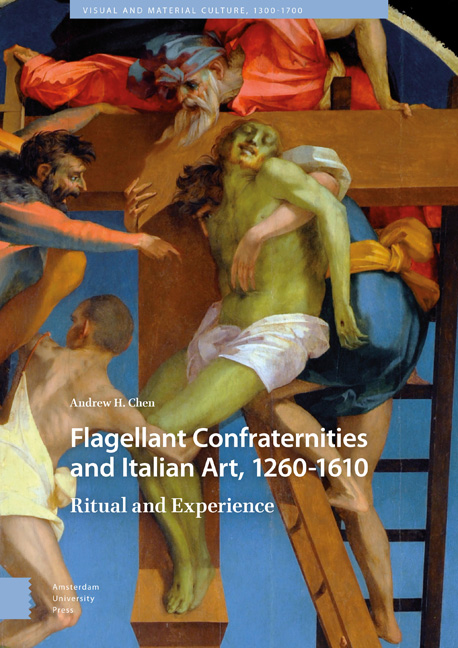Book contents
- Frontmatter
- Deduction
- Contents
- Abbreviations
- List of Illustrations
- Acknowledgements
- Introduction
- Part I Art and Ritual, to 1450
- 1 Flagellation and Its Settings
- 2 Images at Entrances, and Ascesis
- 3 Mass
- 4 Comforting
- 5 Processions
- Part II Transformations
- 6 Changes in Ritual Before Trent
- 7 Changes in imagery before Trent: Sansepolcro and Volterra
- 8 After Trent: Florence and Milan
- Epilogue: Global Flagellation
- Bibliography
- Index of Illuminated Manuscripts (by location)
- Index of Paintings (by location)
- Index of Topics
1 - Flagellation and Its Settings
Published online by Cambridge University Press: 11 December 2020
- Frontmatter
- Deduction
- Contents
- Abbreviations
- List of Illustrations
- Acknowledgements
- Introduction
- Part I Art and Ritual, to 1450
- 1 Flagellation and Its Settings
- 2 Images at Entrances, and Ascesis
- 3 Mass
- 4 Comforting
- 5 Processions
- Part II Transformations
- 6 Changes in Ritual Before Trent
- 7 Changes in imagery before Trent: Sansepolcro and Volterra
- 8 After Trent: Florence and Milan
- Epilogue: Global Flagellation
- Bibliography
- Index of Illuminated Manuscripts (by location)
- Index of Paintings (by location)
- Index of Topics
Summary
A new iconography of the flagellant
In the Chastity severy of the Franciscan Allegories programme in the crossing of the Lower Church of San Francesco in Assisi, the winged personification labelled Penite(n)tia wears a confraternity habit, with hood and an opening between the shoulders (Plate 2). Penitence is a venerable figure, with a beard. We cannot see his face. His back is bloody; he has recently been whipping himself. However, we see him striking not himself but Amor with his whip, expelling the blindfolded figure from the promontory where Chastity lives protected in her castle (Fig. 1).
At Santa Maria Incoronata in Naples, the hospital church founded by Joanna I of Anjou, a vault fresco cycle shows the Seven Sacraments and the Triumph of the Church. It is attributed to Roberto d’Oderisi. The section for the Sacrament of Penance, which faces the viewer as he enters the church from the main portal, shows a woman at confession and three flagellants (Fig. 2). In the upper right, demons flee toward the centre of the vault.
The Assisi composition vividly reminded friars what exactly their vows of chastity entailed. Through penitence they could triumph over carnal love. Chastity also gave them victory over Ardour and Uncleanness, Immunditia, the other personifications being cast down off the cliff. Death, Mors, does battle alongside Penitence. The dark skeletal figure brandishes a sickle and grasps the figure labelled Ardor, a hairy beast with flames rising from his head and shoulders, by the wrist. The relevant part of the inscription accompanying the fresco reads ‘Penitence defends herself with frequent punishment while the memory of death knocks often at the mind’ (DEFENDIT PENITENTIA CASTIGANDO SE CREBRIUS MORTIS REMINISCENTIA DUM MENTEM PULSAT SEPIUS). Representing Penitence as a flagellant lends this otherwise timeless allegory some immediate cultural relevance; the abstract is grounded in local reality. In this period, members of Umbrian flagellant confraternities outwardly expressed the feelings of penitence in their hearts by scourging themselves during private group meetings and in public during processions. Using the whip the flagellant disciplines himself and his carnal desires, the fresco tells us.
The Franciscans offered some of these confraternities spiritual and practical guidance.
- Type
- Chapter
- Information
- Flagellant Confraternities and Italian Art, 1260–1610Ritual and Experience, pp. 33 - 83Publisher: Amsterdam University PressPrint publication year: 2018



